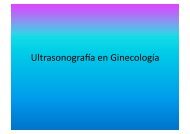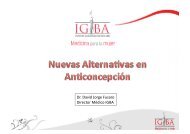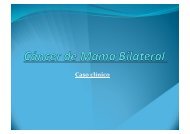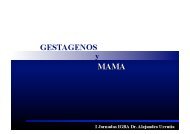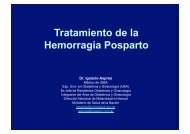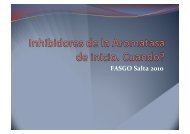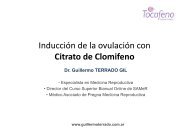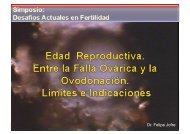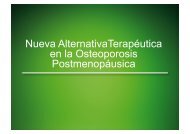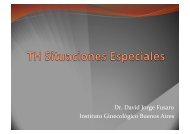SIU LNG - IGBA
SIU LNG - IGBA
SIU LNG - IGBA
You also want an ePaper? Increase the reach of your titles
YUMPU automatically turns print PDFs into web optimized ePapers that Google loves.
Dr. David Jorge Fusaro <br />
Instituto Ginecológico Buenos Aires
Qué es <br />
• Sistema Intrauterino <br />
(<strong>SIU</strong>,Endoceptivo) <br />
• Libera el progestágeno <br />
levonorgestrel (20 µg/día) <br />
• Un <strong>SIU</strong> brinda 5 años de <br />
tratamiento
Funcionamiento <br />
Membrana<br />
<strong>LNG</strong><br />
Pared Uterina<br />
Sección<br />
del sistema
Liberación del levonorgestrel <br />
Contenido total del reservorio: 52 mg de levonorgestrel <br />
Liberación inicial: 20 µg/día <br />
Promedio: 14 µg/día <br />
A los 5 años:11 µg/día <br />
Alos 8 años: 10 µg/día <br />
5 años de eficacia terapéutica
Farmacociné8ca del <strong>SIU</strong>-‐Lng <br />
Liberación continua del fármaco <br />
<strong>SIU</strong> Lng no causa los ‘picos y valles’, observados con la administración <br />
oral de progestinas <br />
Se alcanzan niveles endometriales de progestina muy <br />
elevados, vs administración oral: <br />
Concentración de levonorgestrel<br />
(ng/g de tejido húmedo)<br />
Endoceptivo<br />
(30µg/día)<br />
Administración<br />
oral (250µg)<br />
Endometrio 808 3.5<br />
Nilsson et al., 1982
Cuándo se u8liza el <strong>SIU</strong>-‐Lng <br />
Indicaciones: <br />
Anticoncepción <br />
Menorragia Idiopática <br />
Protección de hiperplasia endometrial <br />
durante la Terapia de Reemplazo con <br />
Estrógenos <br />
Sitruk-‐Ware and Inki. Women’s Health. 2005;1:1
Efectos sobre el moco cervical <br />
• Moco espeso y escaso <br />
• Baja concentración de agua <br />
• del peso del moco <br />
Inhibición de la migración <br />
de los espermatozoides
Efectos sobre el endometrio <br />
Endometrio en estado de reposo:<br />
- Glándulas atróficas<br />
- Mucosa delgada<br />
- Epitelio inactivo<br />
- Supresión de arterias espiraladas<br />
- Trombosis capilar<br />
- Reacción inflamatoria<br />
OLIGOMENORREA / AMENORREA<br />
Zhu P, Contraception. 52;63-68:1995
Farmacociné8ca <br />
<strong>LNG</strong><br />
Capilares Endometrio<br />
Circulación Sistémica
Concentraciónes plasmá8cas de MAC con Lng <br />
7000<br />
<strong>SIU</strong>-Lng<br />
Minipíldora<br />
AOC (250 mcgr <strong>LNG</strong>)<br />
<strong>LNG</strong> Plasma pg/ml<br />
6000<br />
5000<br />
4000<br />
3000<br />
2000<br />
1000<br />
0<br />
Sturridge F., Drug Safety. 15(6);430-440:1996<br />
1 2 3 4 5<br />
Días después del régimen
<strong>SIU</strong> Lng en mujeres nulíparas <br />
El uso del <strong>SIU</strong>-‐Lng en mujeres nulíparas es seguro y <br />
efectivo. <br />
El <strong>SIU</strong> Lng es apropiado para mujeres nulíparas con <br />
dismenorrea y menorragia. <br />
<strong>SIU</strong> Lng: Expulsión, sangrado y dolor ligeramente más <br />
probable en las mujeres nulíparas <br />
Suhonen, et al Contraception. 2004;69:407-‐12; <br />
Hubacher.Contraception. 2007;75:s8; <br />
Prager, et al Contraception.2007;75:s12; <br />
Brockmeyer, et al Eur J Contracept Reprod Health Care. 2008;13:248.
Menorragia <br />
Sangrado menstrual que se presenta en intervalos <br />
normales (21─35 días), pero con <br />
Sangrado abundante (≥ 80 ml) o <br />
Duración prolongada (≥ 7 days) <br />
La pérdida sanguínea menstrual excesiva puede <br />
causar alteración de la calidad de vida y si se <br />
mantiene anemia
Menorragia <br />
Desviación de la definición de consensos <br />
Desviación del ciclo regular individual y “normal” <br />
para cada mujer <br />
Impacto negativo sobre la calidad de vida <br />
Menorragia es “todo” lo que la mujer considera <br />
que es menorragia.
Determinación del flujo sanguíneo menstrual <br />
Método hematina alcalina (Hallberg et al.); <br />
PBAC (gráfico ilustrado de evaluación de pérdida <br />
sanguínea); <br />
TMFL (pérdida de flujo menstrual total); <br />
Evaluaciones de laboratorio (Hb, ferritina); <br />
Número de protectores/ tampones usados
Determinación del flujo sanguíneo menstrual
Menorragia: Realidad vs Percepción <br />
100%<br />
90%<br />
80%<br />
70%<br />
60%<br />
50%<br />
40%<br />
30%<br />
20%<br />
10%<br />
0<br />
80 mL<br />
Sangrado menstrual por ciclo<br />
Percepepción<br />
Del sangrado<br />
menstrual<br />
Severo<br />
Moderado<br />
Leve<br />
Hallberg L, et al. Acta Obstet Gynecol Scand. 1966;45:320.
El “National Institute of Clinical Excellence (NICE)” de <br />
Gran Bretaña define como sangrado abundante: “aquel <br />
que interfiere con lo físico, emocional, social y <br />
calidad de vida de las mujeres y que ocurre solo o en <br />
combinación con otros síntomas” <br />
Esto enfatiza la importancia de focalizar en el impacto <br />
que tiene el sangrado excesivo en el día a día de las <br />
mujeres, más que en el volumen perdido de sangre.
Menorragia <br />
Frecuente en edad reproductiva <br />
30% de las mujeres consideran al sangrado menstrual como <br />
excesivo 1 <br />
20% de las mujeres consultan con el ginecólogo <br />
Mujeres con menorragia <br />
45% utilizan con mayor frecuencia los servicios de salud <br />
38% de las mujeres pierden días de trabajo por esta causa <br />
La anemia y el disconfort reducen su calidad de vida 2 <br />
1. Prentice A. BMJ. 1999;319:343-5; Lethaby A, et al. Cochrane Database Syst Rev. 2000;(2):CD001016;<br />
2.Clark. BJOG.1995;102:611-20.
Menorragia <br />
50%–80% de las mujeres con menorragia no <br />
tienen patología anatómica 3 <br />
50% de las histerecomías son indicadas por <br />
menorragia <br />
1. Prentice A. BMJ. 1999;319:343-5; Lethaby A, et al. Cochrane Database Syst Rev. 2000;(2):CD001016<br />
2.Clark. BJOG.1995;102:611-20.
Causas de menorragia <br />
Idiopática (sin causa aparente) <br />
Miomas <br />
Endometriosis / Adenomiosis <br />
Infecciones genitales <br />
Pólipos endometriales <br />
Hiperplasia de endometrio <br />
Enfermedades malignas <br />
Trastornos endocrinos o de la coagulación <br />
Algunos medicamentos
Menorragia:Tratamientos médicos <br />
AINEs <br />
ACO <br />
Progestágenos en la segunda mitad del ciclo <br />
Supresión del endometrio <br />
Progestágenos contínuos <br />
POP <br />
ACO de rango extendido <br />
GnRH <br />
<strong>SIU</strong>-‐<strong>LNG</strong>
<strong>SIU</strong>-‐Lng en el tratamiento de la menorragia <br />
% Reducción <br />
86% <br />
91% <br />
97% <br />
* * * <br />
(≥80mL MBL = menorragia) <br />
* p
<strong>SIU</strong>-‐Lng incrementa hemoglobina y <br />
ferri8na plasmá8cas <br />
# <br />
#<br />
p
<strong>SIU</strong>-‐Lng vs AINEs <br />
Ac.<br />
<strong>SIU</strong>-Lng Flurbiprofeno Tranexámico<br />
Pérdida menstrual<br />
Cambio % desde la basal<br />
*** <br />
* <br />
** <br />
* P
<strong>SIU</strong>-‐Lng vs. MAP <br />
Randomizado, multicéntrico, abierto <br />
50 sitios en USA, Canadá and Brasil <br />
Mujeres (n=138), >18 años, con por lo menos 2 ciclos de <br />
menorragia de ≥80 mL en los últimos 3 ciclos de la fase de <br />
screening <br />
Criterios de exclusión: mujeres con diagnóstico de causa <br />
orgánica de menorragia o contraindicación para el <strong>SIU</strong> Lng o <br />
MAP <br />
Seguimiento: 6 ciclos <br />
<strong>SIU</strong> Lng <br />
MPA 10 mg/día por ciclo del día 16-‐25
Caracterís8cas Basales <br />
Edad(años)<br />
IMC<br />
Ciclo (días)<br />
Días de<br />
sangrado<br />
<strong>SIU</strong> <strong>LNG</strong><br />
(n=82)<br />
MPA<br />
(n=83)<br />
Promedio SD Promedio SD
Sangrado menstrual promedio <br />
160<br />
140<br />
120<br />
100<br />
SMP<br />
80<br />
60<br />
40<br />
20<br />
0<br />
Siu lNG<br />
MAP<br />
Basal 3 meses 6 meses
Percepción de cambio a los 3 y 6 ciclos <br />
0<br />
Percepción de cambio %<br />
–10<br />
–20<br />
–30<br />
–40<br />
–50<br />
–60<br />
–70<br />
–80<br />
–62<br />
–11<br />
–71<br />
–22<br />
Siu lNG<br />
MAP<br />
P
Tratamiento exitoso <br />
<strong>SIU</strong> Lng<br />
MAP<br />
15.2%<br />
84.8%<br />
SI<br />
No<br />
77.8%<br />
22.2%<br />
P
Menorragia: Opciones quirúrgicas <br />
Histerectomía <br />
Vaginal <br />
Abdominal <br />
Laparoscópica <br />
Ablación/Resección endometrial <br />
Laser <br />
Balón térmico <br />
Microondas <br />
Resección transcervical del endometrio (TCRE) <br />
Instilación de líquidos <br />
Crioterapia
<strong>SIU</strong>-‐Lng y Resección endometrial: <br />
Efectos comparables <br />
Sangrado promedio (score)<br />
Basal<br />
12 meses<br />
<strong>SIU</strong>-Lng<br />
Resección<br />
endometrial<br />
<strong>SIU</strong>-lng vs hystereroscopic endometrial resection in the treatment of dysfunctional Bleeding.<br />
Crosignani et al. Obstet Gynecol 1997; 90: 257-63
<strong>SIU</strong>-‐Lng y Resección endometrial <br />
Ambos tratamientos incrementan <br />
significativamente la hemoglobina sérica , el <br />
hematocrito y el hierro <br />
Incremento promedio desde la basal<br />
Hemoglobina (g/<br />
L)<br />
Hematocrito<br />
(%)<br />
Hierro sérico<br />
(mg/L)<br />
<strong>SIU</strong>-Lng <br />
21<br />
5.7<br />
522<br />
Ablación endometrial /<br />
resección<br />
22<br />
5.9<br />
558<br />
<strong>SIU</strong>-lng vs hystereroscopic endometrial resection in the treatment of dysfunctional Bleeding.<br />
Crosignani et al. Obstet Gynecol 1997; 90: 257-63
<strong>SIU</strong>-‐Lng y resección endometrial <br />
Ambos tratamientos están asociados con altos <br />
rangos de satisfacción <br />
Proporción de mujeres satisfechas<br />
o muy satisfechas (%)<br />
<strong>SIU</strong>-Lng<br />
Resección<br />
endometrial<br />
<strong>SIU</strong>-lng vs hystereroscopic endometrial resection in the treatment of dysfunctional Bleeding.<br />
Crosignani et al. Obstet Gynecol 1997; 90: 257-63
<strong>SIU</strong>-‐Lng vs. Ablación <br />
Sin diferencias en los promedios de fallas al tratamiento <br />
21.2% vs.17.9% <br />
Ambos métodos mejoran en forma similar la calidad de vida <br />
Menor necesidad de analgésia/ anestesia en el grupo <strong>SIU</strong> <br />
Lng <br />
La ablación requiere un método anticonceptivo adicional <br />
efectivo <br />
Alteración de la placentación en embarazos postablación <br />
Kaunitz AM, et al. AJOG. 2009 May;113(5):1104-16b.
<strong>SIU</strong>-‐Lng y ablación/resección <br />
Estudios compara8vos <br />
Estudio N Reducción del sangrado<br />
menstrual<br />
Henshaw et al., 2002<br />
<strong>SIU</strong> Lng<br />
Microwave ablation<br />
Barrington et al., 2003<br />
<strong>SIU</strong> Lng<br />
Thermal balloon ablation<br />
Istre and Trolle, 2001<br />
<strong>SIU</strong> Lng<br />
TCRE<br />
Kittelsen and Istre, 1998<br />
<strong>SIU</strong> Lng<br />
TCRE<br />
20<br />
35<br />
25<br />
25<br />
30<br />
29<br />
24<br />
29<br />
82% (media 20.9 meses)<br />
73% (media 8.3 meses)<br />
71% (6 meses)<br />
50% (6 meses)<br />
90% (12 meses)<br />
98% (12 meses)<br />
90% (12 meses)<br />
98% (12 meses)<br />
TCRE; transcervical resection of the endometrium
<strong>SIU</strong>-‐Lng e Histerectomía <br />
Proporción de mujeres que cancelaron su<br />
histerectomía a 6 meses<br />
Proporción de mujeres (%) <br />
100 <br />
90 <br />
80 <br />
70 <br />
60 <br />
50 <br />
40 <br />
30 <br />
20 <br />
10 <br />
0 <br />
64%<br />
Mirena <br />
*p
<strong>SIU</strong>-‐Lng e Histerectomía <br />
Una alta proporción de portadoras de <strong>SIU</strong> Lng y aquellas a quienes se <br />
efectuó histerectomía estuvieron satisfechas o muy satisfechas con su <br />
tratamiento a 5 años de seguimiento <br />
Proporción de satisfechas <br />
y muy satisfechas (%) <br />
100 <br />
90 <br />
80 <br />
70 <br />
60 <br />
50 <br />
40 <br />
30 <br />
20 <br />
10 <br />
0 <br />
94 93 <br />
<strong>SIU</strong> Lng <br />
Histerectomía <br />
Hurskainen et al. JAMA 2004; 291: 1456-63
<strong>SIU</strong>-‐Lng e Histerectomía <br />
Los costos totales (directos e indirectos) de la atención médica <br />
fueron 40% más bajos con <strong>SIU</strong> Lng que con la histerectomía a 5 <br />
años de seguimiento <br />
Costos totales (US dls) <br />
5000 <br />
4000 <br />
3000 <br />
2000 <br />
1000 <br />
0 <br />
2817 <br />
<strong>SIU</strong> Lng <br />
4660 <br />
Histerectomía <br />
Hurskainen et al. JAMA 2004; 291: 1456-63
<strong>SIU</strong>-‐Lng e Histerectomía <br />
<strong>SIU</strong>-‐Lng: <br />
• conserva la fertilidad <br />
• es accesible en niveles primarios de atención <br />
• evita el riesgo de los procedimientos quirúrgicos <br />
• relación beneficio/costo <br />
<strong>SIU</strong>-‐Lng es una alternativa frente a la histerectomía <br />
para el tratamiento de la menorragia
<strong>SIU</strong>-‐Lng e Histerectomía <br />
“El uso del Sistema Intrauterino Liberador de <br />
Levonorgestrel es una alternativa conservadora a la <br />
histerectomía en el tratamiento de la menorragia y <br />
debería ser considerada antes de ésta o de cualquier <br />
otro tratamiento invasivo <br />
Open ramdomised study of the use of <strong>SIU</strong>-lng as alternative to hysterectomy.<br />
Lähteenmäki et al. BMJ 1998; 316: 1122-6
Rol de <strong>SIU</strong>-‐Lng en el tratamiento de <br />
la menorragia <br />
Altamente efectiva en <br />
reducir la pérdida sanguínea <br />
Bien tolerado <br />
Alta tasa de <br />
satisfacción <br />
para la usuaria <br />
Relación <br />
beneficio/costo <br />
Alta tasa <br />
de <br />
continuación <br />
con Mirena ®<br />
Eficaz alternativa <br />
a la cirugía <br />
Anticoncepción <br />
efectiva <br />
Conserva <br />
la <br />
fertilidad
Conclusiones <br />
<strong>SIU</strong>-‐Lng y menorragia : <br />
No tiene las complicaciones de la cirugía <br />
Es mejor que los otros tratamientos clínicos <br />
Preserva la fertilidad <br />
Ofrece anticoncepción al mismo tiempo <br />
Dura 5 años <br />
Relación costo/beneficio <br />
Provee protección endometrial en la post-‐menopausia <br />
Milsom I, et al. Am J Obstet Gynecol. 1991;164(3):879-83; Endrikat, et al. J Obstet Gynaecol Can.<br />
2009;31(4):340-347; Kaunitz AM, et al. AJOG. 2009 May;113(5):1104-16b; Hurskainen R, et al.<br />
Lancet. 2001;357(9252):273-7.
Segundo <strong>SIU</strong>-‐Lng <br />
Objetivos <br />
• Evaluar el patrón de sangrado después del <br />
primer año del segundo <strong>SIU</strong> <br />
• Datos de Inserción – grado de facilidad de <br />
extracción y recolocación – dolor en extracción y <br />
recolocación <br />
• Porcentajes de continuación y Efectos adversos <br />
Rönnerdag and Odlind. Acta Obstet Gynecol Scand. 1999;78:716-‐21.
Segundo <strong>SIU</strong>-‐Lng <br />
Resultados: <br />
• Principal razón para no continuar: menopausia , <br />
no necesidad de anticoncepción <br />
• Bajo porcentaje de expulsión: (1.2%) <br />
• Alta efectividad anticonceptiva: 0 embarazo <br />
• Discontinuación 2 <strong>SIU</strong> es muy rara <br />
Rönnerdag and Odlind. Acta Obstet Gynecol Scand. 1999;78:716-‐21.
Segundo <strong>SIU</strong>-‐Lng <br />
Resultados: <br />
1er <strong>SIU</strong> Lng <br />
Rönnerdag and Odlind. Acta Obstet Gynecol Scand. 1999;78:716-‐21.
Segundo <strong>SIU</strong>-‐Lng <br />
2do <strong>SIU</strong> Lng
Segundo <strong>SIU</strong>-‐Lng
Segundo <strong>SIU</strong>-‐Lng <br />
Extracción <br />
Fácil <br />
Difícil <br />
Difícil 3,5% <br />
Fácil 96,5%
Segundo <strong>SIU</strong>-‐Lng <br />
Inserción <br />
Fácil <br />
Difícil <br />
Difícil 13% <br />
Fácil 87%
Segundo <strong>SIU</strong>-Lng
<strong>SIU</strong> Lng Efectos adversos <br />
Quistes de ovario 8 3.9 % <br />
Acné 7 3.5 % <br />
Tensión mamaria 5 2.5 % <br />
Mastalgia 4 2.0 % <br />
Dolor Abdominal 4 2.0 % <br />
-‐ Bajo 4 2.0 % <br />
-‐ Alto 3 1.5 % <br />
Candidiasis 3 1.5 % <br />
Ceafalea 3 1.5 % <br />
Quistes hemorrágicos 3 1.5 % <br />
Rönnerdag and Odlind. Acta Obstet Gynecol Scand. 1999;78:716-‐21.
<strong>SIU</strong> Lng Efectos adversos <br />
Mundo de la investigación vs mundo Real <br />
Mujeres de 20 – 45 años <br />
Solo por anticoncepción <br />
Menorragia: 25 % <br />
No incluyeron pacientes en transición a la menopausia <br />
Rönnerdag and Odlind. Acta Obstet Gynecol Scand. 1999;78:716-‐21.
Asistir sin invadir<br />
Optimizar la elección



